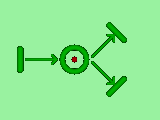Ready.
Playing with Petri Nets
The intension of this page is to underline the usage of Petri nets as a non-boring, open-ended board game and also to provide a background in Petri nets so that the interested readers could go on for a separate excursion in discovering an un-credible Ph.D. dissertation that I have deciphered, and not to mention the context of my general world-view, which also features educational aspects, as a part of which I would also like to make various areas of knowledge into edutainment, and the first of my edutainment launches being, as it happens to be, the Petri nets as a board game and for modeling of events we observe around.
That first sentence was the longest sentence on this page. If you could read and understand it, you will very likely understand the rest of this page, too. Congratulations!
Petri nets
Petri nets have only four types of basic elements. They are the places, the transitions, the tokens, and the arrows. Places hold the tokens. Transitions carry tokens among the places. And the arrows tell us from which places a transition may receive the tokens, and to which places it will deposit.
In figures, places are shown with circles. Transitions are drawn as thin rectangles (boxes).
At any time, some places may have tokens, and others may not. The collection of places that have tokens at a given moment is called a marking.
In Germany, the money they use is called a mark. In the united states (America), it is called a dollar. I do not guess the name is a marking because Mr.Petri had developed the Petri nets in Germany. But, in any case, I will call the collection a doll-a-ring.
Calling it a doll-a-ring may be especially meaningful because we will be modeling the world around us, and it is just like dolls versus humans. They are not the same. But they look like each other. And dolls are usually considered more valueable when they reflect humans better. e.g:When they talk, when they walk, etc.
Let's start with some examples.
Example 1: At the kitchen table.

The parents bring food. Kids eat. (Any objections? O.K. Forget the objections. This is what we have here.)
A transition that has no incoming arrows is called a source transition. That means it does not need any inputs for producing tokens. That is not exactly true for parents. They have to earn money, buy vegetables, etc. And the kids could also help in the kitchen, or if they have cows, they may milk the cow, etc. But most usually, for parents with kids, this is what it is. And when we also model the other aspects, this figure may also find a corner for itself.
A transition box that has no arrows going out is expected nothing to produce. It only eats tokens. Of course, this is only what we model so far. This is not what the real kids do, most usually. After eating, the kids may use their computers, learn, play, talk with people, etc. The idea of no-output-transition is more like for the kitchen sink, where whatever you deposit is gone. And such a transition is indeed called a sink transition.
Each time there is something to eat, at the place, one of the siblings may consume it.
Referring#: 0.0.1.0
Last-Revised (text) on Sept. 21, 2003 . . . that was http://www.geocities.com/ferzenr/fun.petrinet.htm
looks-and-links, and keyword update: July 25,2004
mirror to mid80.net, on June 15, 2009
Written by: Ahmed Ferzan/Ferzen R Midyat-Zila (or, Earth)
Copyright (c) [2002,] 2003, 2004, 2009 Ferzan Midyat. All rights reserved.